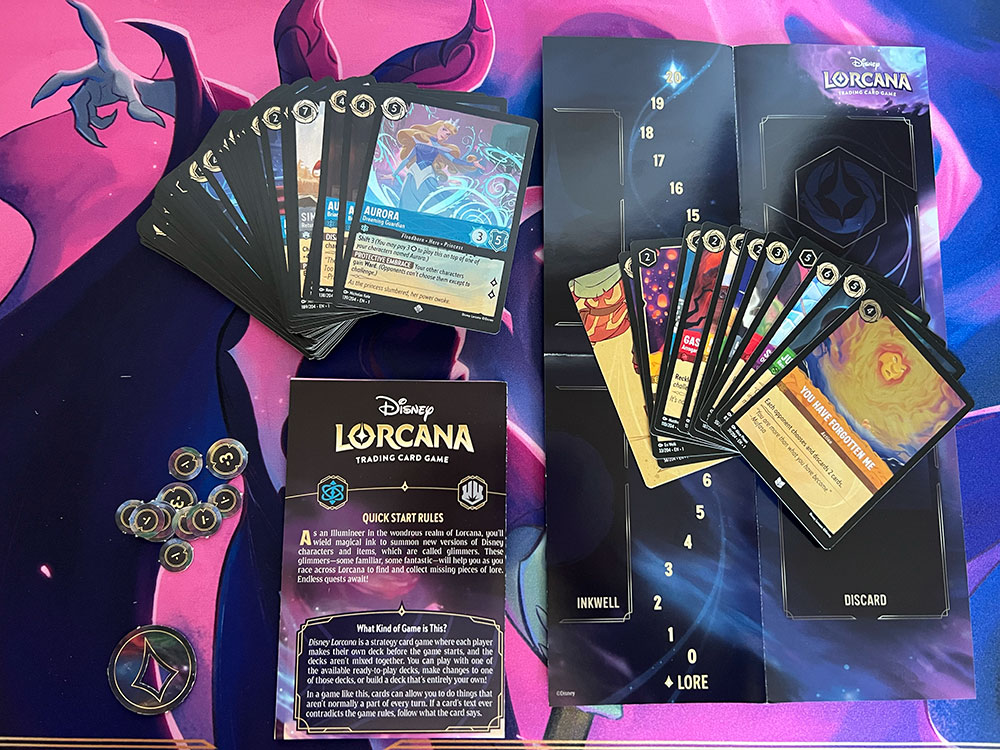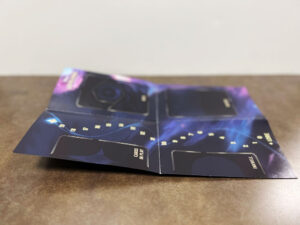 Minnie Mouse faces off against Maleficent, waging an epic battle of ink-slinging mayhem. Minnie challenges. Maleficent scrapes through, defending herself by the narrowest of margins, allowing her to go on a bold quest to gather forgotten storybook lore. The evil sorceress reigns triumphant, collecting just enough lore to win the day! It’s a heroic game of art and magic, cunning and valor.
Minnie Mouse faces off against Maleficent, waging an epic battle of ink-slinging mayhem. Minnie challenges. Maleficent scrapes through, defending herself by the narrowest of margins, allowing her to go on a bold quest to gather forgotten storybook lore. The evil sorceress reigns triumphant, collecting just enough lore to win the day! It’s a heroic game of art and magic, cunning and valor.
It’s Disney Lorcana, the new trading card game by Ravensburger.
Gameplay Overview:
Lorcana has two modes of play: The 2-player head-to-head duel, and a multiplayer battle royale. The rules are the same for both, with each player taking on the role of a magical Illumineer. Somewhere in the outer reaches of the Disney universe is the Great Illuminary, a mystical place with the power to combine the light of story stars with magical ink to summon glimmers of famous Disney characters. Illumineers use their glimmers to accomplish the ultimate goal of collecting bits of storybook lore from around the universe and bringing them back to the Illuminary. Lore functions as victory points and the player who can gather twenty lore the fastest wins.
Players manage a resource pool of ‘ink’, and a qualifying card from their hand can be added to the inkwell each turn. Cards have ink values that must be paid to be played, and character cards usually need to wait a turn for their “ink to dry” before they can choose to either quest for lore or challenge an opponent.
Character cards have attack and defense values, each character taking damage in a challenge, and they are banished to the discard pile when the damage equals their defense. Additional cards include items, actions, and special actions called Songs that characters with a high enough value can exert themselves to ‘sing’ rather than paying an ink cost.

Game Experience:
I’ve wanted to get into trading card games (TCG) in the past, but the barrier for entry always felt too high, with too many years of lore and rules updates to sort through. As soon as Lorcana was announced, I knew I was going to go wild for it, but I worried that the gameplay wouldn’t stand up against the hype around it. Ravensburger has an impressive back catalog of material to work with in the Disney Universe, but will the game hold up to repeated play for someone with a primarily board game background?
Thankfully, it does.

One starter deck per player is really all that’s needed to dive in and start enjoying the game. Each includes a 60-card deck composed of two of the six possible ink colors, cardstock damage tokens, quick start instructions, a paper playmat, and a booster pack. The booster packs have 12 cards a piece, with a guaranteed rare and a foil in each. The cards themselves are gorgeous, showing off all new art created for the game. The new illustrations make the game feel cohesive despite the movies that are featured spanning decades. I love seeing deeper cuts like The Three Musketeers making an appearance. While a lot of value is packed into these starter decks, the playmat and damage counters are pretty flimsy. I don’t see many people using them as is.
The three starter decks are well-balanced to go head-to-head with each other. After a dozen games playing as a TCG beginner against my Magic: The Gathering loving partner, we consistently managed to hit the goal of twenty lore within a turn or two of one another. Games move quickly, and we kept asking each other for just one more round so we could try new strategies and card combos. The card configurations in the starter decks mostly focus on building your own character bench up and challenging as needed instead of outright aggression. Play can be tense as you approach 20 lore, but the game rewards both lucky draws and smart plays.

Rules for deck building require a maximum of two colors per deck, with a minimum of 60 cards included, and the cards come in six levels of rarity, with the sixth being ‘enchanted’ alternate art foil cards. The ink colors nominally have their own identity, although in this first chapter, the differentiation is a light touch. In the Sapphire/Steel deck, the Sapphire cards theoretically allow you to ramp up your ink production, and Steel focuses on dealing direct damage. You may go through a whole starter deck duel without drawing cards that highlight these differences, though. As further cards are released and there are more deckbuilding options, these color identities will likely become more evident.
Lorcana also gave me my first opportunity to go to a tournament at my local game store. The organized play events I’ve been to so far have all had a very welcoming vibe, with lots of newcomers and families playing alongside hardened TCG pros. However, supply distribution has been a major issue with the game release, and a reprint of the first chapter is already in the works in time for the holiday season. If you can get your hands on Lorcana, though, it’s hard not to feel the Disney Magic.
Final Thoughts:
Disney Lorcana is a great family game, and a good entry point to the world of trading card games. The production is beautiful, and the starter decks are well designed for introductory play with plenty of opportunities for strategic deck building.
Final Score: 4 stars – A very playable game that will satisfy Disney superfans and TCG fans alike.
 Hits:
Hits:
• Beautiful art
• Cards are delightfully thematic
• Fun to be had by gamers at all levels of experience
Misses:
• Production values on some items feel cheap
• Card colors blend into one another because their identities are vague
Source: Board Game Quest





